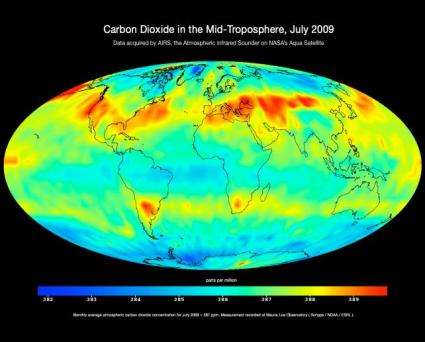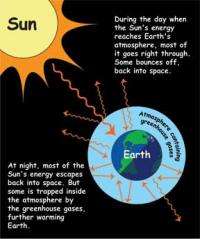Alien Climates Play Key Role in Possibility of Life

A new study of how climate conditions have affected the origin and evolution of life on Earth could provide clues to understanding how climates on alien planets might affect their potential for life.
Greenhouse gases have a bad reputation because of the role they’re playing in global warming on Earth today. However, scientists say we also owe our lives to greenhouse gases because they might have allowed life to take hold in the first place.
A new study of how these and other climate conditions have affected the origin and evolution of life on Earth could provide clues to understanding how climates on alien planets might affect their potential life.
Greenhouse gases heat the planet by letting light in and then trapping heat beneath, increasing the ambient temperature of the ground.
Scientists think the Sun used to shine less brightly when the Earth was young, so the early Earth should have been cooler than it is today. But greenhouse gases such as methane and carbon dioxide played an important role at this time, warming the planet to a point where it was habitable for life.
“The problem was, the Sun was fainter and the energy input to the atmosphere was reduced,” said J. Lee Grenfell, an atmospheric chemist at the Technische Universität Berlin in Germany and lead author of the study recently featured in the journal Astrobiology. “We need to explain how, despite a fainter Sun, the surface could be warm enough to host liquid water.”
Gaseous molecules like methane may have worked to heat the planet, keeping the oceans fluid and not frozen. Since liquid water is a prerequisite for Earth’s life, the greenhouse gases may have therefore played an important role in making the planet habitable.
Grenfell uses knowledge about Earth’s climate to build atmospheric computer models and applies them to hypothetical extraterrestrial planets. For example, he can adjust the type of parent star the planet orbits around, and the distance of the orbit, to monitor the affects these variations would have on climate.
"As our knowledge deepens in future, we will extend our models to include, for example, interactions between the atmosphere and oceans and geological processes," Grenfell said.

While experts don’t know for sure that alien life would need water to survive, the presence of liquid water remains one of the most promising signs we can look for in the hunt for extraterrestrials.
“The biologists tell us that certainly life as we know it on Earth needs liquid water to establish itself to thrive, to reproduce,” Grenfell said. “Liquid water requires certain climate conditions - and habitats for life on Earth occur over a large temperature range, approximately between 0 degrees Celsius [32 degrees Fahrenheit] up to maybe 120 degrees Celsius [248 degrees F]. Different types of microorganisms adapt to their particular niche temperature over this wide range. Complex life can survive and thrive from about 0 to 30 degrees Celsius."
The greenhouse effect is known to occur on other planets. For example, on Venus, where the atmosphere is composed primarily of carbon dioxide, the greenhouse effect is very efficient, pushing surface temperatures there above 860 degrees Fahrenheit (480 degrees Celsius). That’s too hot for liquid water to exist, but Venus may have had oceans when it was younger. As the Sun and planet warmed over time, however, every drop of water in Venus’s ocean would have boiled away.
While greenhouse gases may have enabled life on Earth, life also interacts with greenhouse gases. Both the methane and carbon dioxide in our planet’s atmosphere are today largely produced by living things. From bacterial organisms to cows, life emits methane as a waste product. Carbon dioxide is also created by life - you exhale carbon dioxide with every breath you take. Thus, the molecules in the atmosphere and the life on Earth affect each other in a continuous feed-back cycle. Life that evolved early in Earth’s history began influencing these molecules, which then changed the climate even more to the point where new forms of life could evolve and affect the climate.

“The Earth is the only example we have where life has changed the atmosphere of the planet,” Grenfell said. “If the Earth had evolved without life, or if life was switched off, the climate would be very different.”
Studying this relationship between climate and life on Earth could point toward ways to search for life beyond Earth, he said. For example, on Earth, the simultaneous presence of methane and oxygen in large quantities serves as a bio-marker, or a sign that life is present. Oxygen is often a byproduct of life and therefore could be a tell-tale fingerprint of the existence of life elsewhere.
“The problem is, you have to be careful, because there are non-life processes which could also produce oxygen,” Grenfell said. “Each case would have to be evaluated according to our models and according to our understanding.”
Provided by Astrobio.net



















